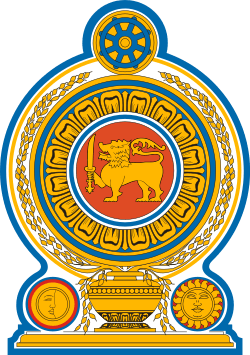Department of Archaeology (Sri Lanka)
| පුරාවිද්යා දෙපාර්තමේන්තුව | |
 | |
| Agency overview | |
|---|---|
| Formed | 1890 [1] |
| Jurisdiction | Sri Lanka |
| Agency executive |
|
| Website |
www |
The Department of Archaeology is a non-ministerial government department in Sri Lanka responsible for managing the archaeological heritage.
History
On 7 July 1890 the Governor of Ceylon, Sir Arthur Gordon, appointed Harry Charles Purvis Bell as the first Archaeological Commissioner and Head of the Archaeological Survey of Ceylon. The Survey consisted of the Commissioner, a European assistant commissioner, a native assistant, a clerk, and three draughtsmen. The first task given to the Survey was the exploration, excavation, mapping and conservation of historical monuments at Anuradhapura. In 1895 the Survey commenced work at Sigiriya and in May 1900 at Polonnaruwa. Between 1902 and 1907 John Still (the author of Jungle Tide) served as assistant commissioner.
On 8 December 1912 Edward Russell Ayrton was appointed Archaelogical Commissioner, having previously worked as the assistant commissioner under Bell. On 18 May 1914 Ayrton drowned at Tissa Wewa in Tissamaharama. The Archaelogical Department all but closed down, with only a skeleton staff, during World War I, with a series of acting heads. It wasn't until the appointment of Arthur Maurice Hocart in 1921 that the Department became more active. Hocart recognised the need to train young Ceylonese to work in the department, and amongst his protégées was Senarath Paranavithana, who was sent in 1923 to Ootacamund to train under the Government Epigraphist in India. In 1925 Hocart took a year's leave and returned to England. In his absence M. Wedderburn acted as Archaeology Commissioner. Upon his return in 1926 Hocart appointed Paranavithana as the Epigraphical assistant. When Hocart retired in 1929 C. F. Windsor took the role of Commissioner and at this time the head office of the Archaeological Department was relocated from Anuradhapura to Colombo.
In 1932 when Windsor retired Senarath Paranavithana became the first Sri Lankan to be appointed as head of the Department. In 1935 Albert Henry Longhurst took over the role of Archaeological Commissioner and Paranavithana was his Epigraphical assistant. Longhurst was previously the Superintendent of the Archaeological Survey of India. During his tenure in Ceylon he concentrated on the conservation of monuments, particularly in Polonnaruwa. With commencement of World War II all the major works of the department were suspended and Dr Paranavithana was appointed as Commissioner. After the country gained its independence the Archaeological Department went through a significant phase of expansion, with its activities expanded to almost every district on the island.
When Paranavithana retired in 1956 the position of Commissioner was taken by Charles Godakumbura, a role in which he occupied until his retirement in 1967. Raja H. de Silva was then appointed as the new Commissioner.
Archaeological Commissioner
| No. | Archeological Commissioner | Year (commence) | Year (complete) |
|---|---|---|---|
| 1 | Stephen Montague Burrows | 1884 | 1886 |
| 2 | Harry Charles Purvis Bell | 1890 | 1892 |
| 3 | R. W. Levers (Acting) | 1892 | 1892 |
| 4 | Harry Charles Purvis Bell | 1893 | 1912 |
| 5 | Edward Russell Ayrton | 1912 | 1913 |
| 6 | B. Constantine | 1913 | 1914 |
| 7 | H. R. Freeman (Acting) | 1914 | 1918 |
| 8 | F. G. Tyrrel (Acting) | 1918 | 1920 |
| 9 | A. W. Seymour (Acting) | 1920 | 1921 |
| 10 | G. F. R. Browning (Acting) | 1921 | 1922 |
| 11 | Arthur Maurice Hocart | 1922 | 1924 |
| 12 | M. Wedderburn (Acting) | 1924 | 1925 |
| 13 | Arthur Maurice Hocart | 1925 | 1927 |
| 14 | E. T. Dyson (Acting) | 1927 | 1928 |
| 15 | C. F. Windsor | 1929 | 1929 |
| 16 | J. Pearson (Acting) | 1929 | 1930 |
| 17 | C. F. Windsor | 1930 | 1932 |
| 18 | Senarath Paranavithana | 1932 | 1934 |
| 19 | Albert Henry Longhurst | 1935 | 1939 |
| 20 | Senarath Paranavithana | 1940 | 1956 |
| 21 | Charles Godakumbura | 1956 | 1967 |
| 22 | Raja H. de Silva | 1967 | 1979 |
| 23 | Saddhamangala Karunarathna | 1979 | 1983 |
| 24 | Roland Silva | 1983 | 1990 |
| 25 | M. H. Sirisoma | 1990 | 1992 |
| 26 | S. U. Deraniyagala | 1992 | 2001 |
| 27 | W. H. Wijayapala | 2001 | 2004 |
| 28 | Senerath Dissanayake | 2004 | current |
See also
References
- 1 2 "History of the Department of Archeology". Retrieved 2015-11-29.